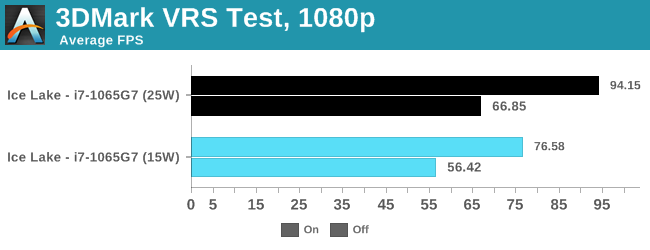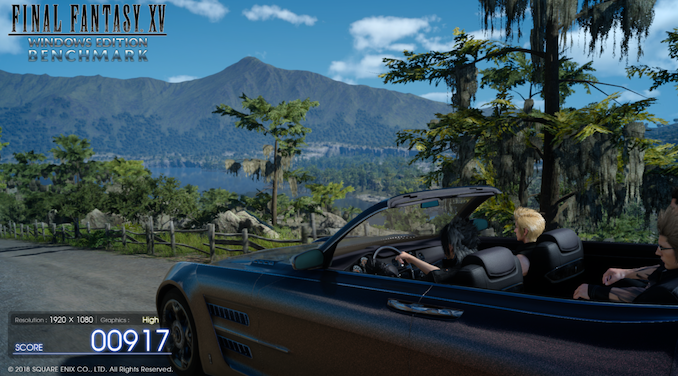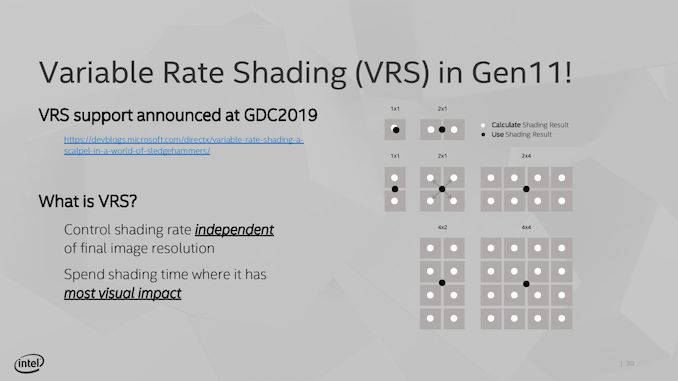The Ice Lake Benchmark Preview: Inside Intel's 10nm
by Dr. Ian Cutress on August 1, 2019 9:00 AM EST- Posted in
- CPUs
- Intel
- GPUs
- 10nm
- Core
- Ice Lake
- Cannon Lake
- Sunny Cove
- 10th Gen Core
Gaming Results (15W and 25W)
One of the biggest changes to the Ice Lake design is in the integrated graphics – Intel is now giving more focus and more die area to graphics, something it has arguably been neglecting for several years now. With Ice Lake, we move to a Gen11 graphics architecture, which is almost like the previous Gen9.5 but now with added support for variable rate shading (VRS), moving from 24 EUs to 64 EUs, and memory support up from LPDDR3-2133 to LPDDR4X-3733.


World of Tanks is a very CPU driven benchmark, and having the extra frequency of the 25W processor does help here. We're getting a sizeable uplift from Whiskey Lake, due to the extra EUs and memory frequency.


Our Final Fantasy test seemed to regress in 25W mode, although still within the noise. This test is still GPU bound, so adding the extra TDP to the CPU didn't actually help much. However, comparing to the Whiskey Lake integrated graphics, we've got over a 2x speedup.


Similarly with Civilization, with what is normally our 'IGP' settings, we are still GPU limited here.
One of Intel's newest features is Variable Rate Shading.
If developers add the option, soon to be an easy checkbox in Unity and Unreal, the game can decide to control the rate at which it shades pixels, from calculating every pixel down using one result across a 4x4 grid, to save compute power. Currently the only way to test this is with the 3DMark functional demo.

The new VRS test in 3DMark is designed as a feature test to show the potential uplift effect from enabling variable rate shading within a game. In both 15W and 25W modes, the data saw a good uplift, and we seemed to get more out of the 25W mode than the 15W mode.














261 Comments
View All Comments
KAlmquist - Friday, August 2, 2019 - link
So Intel has produced a significant jump in IPC for for the first time in a long while, but they aren't going to bring it to the desktop any time soon. 7nm is targeted for 2021, but even if it is delivered on time the plan is to initially use it for data center products (a General-Purpose Graphics Processing Unit, to be followed by some Xeon processors). I've been expecting Ryzen 3XXX prices to fall over the next six months, but AMD may have no reason to reduce prices if Intel isn't planning to compete.Comagnum - Thursday, August 1, 2019 - link
These processors look.. unimpressive.PeachNCream - Thursday, August 1, 2019 - link
Yup.Arbie - Thursday, August 1, 2019 - link
The gaming results section would really benefit from a clear statement of the video resolution in each case (I didn't see that anywhere in the article), and at least one comparison to a discrete graphics card.Ian Cutress - Thursday, August 1, 2019 - link
It's there in the title of the graphArbie - Friday, August 2, 2019 - link
I've been through too many generations of monitors, I guess. The default now would be 16:9 so the title bar numbers are clear enough. Except World of Tanks resolution wasn't apparently listed; but that's rare enough that I doubt it would be much use in comparing to other GPUs.Elstar - Thursday, August 1, 2019 - link
This appears to be an editing error:"POPCNT Microcode 50% faster than SW (under L1-D size)"
The comment must apply to something other than POPCNT (which is trivial to implement). I'd wager this comment refers "REP MOVS" given the next line is about "REP STOS".
nivedita - Thursday, August 1, 2019 - link
“Throughout most of the last decade, Intel has kept the same cache configuration among its server cores with very few changes, aside from improving the micro-op cache through Sandy Bridge today, but with Sunny Cove, we get some key updates.“Didn’t the cache hierarchy change considerably in skylake, with l2 growing and l3 becoming non-inclusive? Or am I misremembering?
Elstar - Thursday, August 1, 2019 - link
You're thinking about the server variant of Skylake. This article is about the "client" variant of Skylake (i.e. the one with integrated graphics, etc) and therefore the commentary about caches is valid.psychobriggsy - Thursday, August 1, 2019 - link
1. Still months from availability, so this is a very early preview. This is obviously going to bring up cries of paper launch and Intel marketing, but no website would have turned it down. I don't think the article is kind.2. Gains are negligible.
3. Lower base clocks, all-core turbo and 1C turbos are highly concerning for the 10nm process compared to Whiskey Lake.
4. 'extra binning required' for the 28W SKU means that not many dies can make this, this is the 10nm limit for Intel.
5. AVX512 is a beast
6. Better GPU drags Intel from being way-behind to not being an embarrassment.